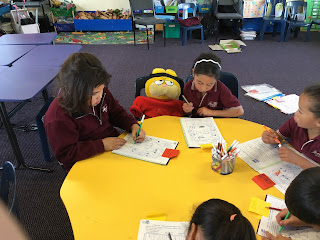We go down there every year to plant trees and this year we were able to see how much our trees which we had planted 3 years ago were growing. They are now a bit taller than Waitama! (He's pretty tall too!). So we decided that in 20 years time they are going to be very tall!
We arrived and Nic had already dropped off all the trees and was busy digging holes for us. We gathered up everything we would need and got into pairs to begin planting.
When planting trees it is important to make sure they are covered at the base of the plant- but not too or too low, as this could either kill the weeds or suffocate the plant.
We had little fertiliser discs to drop into the holes before putting the plants in, and then we put a green stake next to our tree so that if the grass grows faster than the tree we will still be able to find it.
Once we had planted all the trees we had morning tea. It was a break well earned for some of our busy tree planters, who were planting try very quickly and effectively.
After morning tea we got into our house groups and set about putting the penguin houses out. Penguins don't enjoy wet feet inside their houses so we made sure we put them up high away from the tide. We put some of them next to our three year old trees so that in the years to come the penguin can enjoy the shade of the trees.
We had a fun morning getting a lot done.
A very big thank you to everyone who came and helped us. We wouldn't have enviro-school days without you!
 |
| Nic telling us about what has been trapped so far. |
 |
| Tarquinn-Zaid with one of our penguin houses. |
 |
| Whangawehi Awa |
 |
| Lucy and Lisa planting their trees. |
 |
| Morning Tea time! |
 |
| Shevy resting after lifting his penguin house into place! |




























